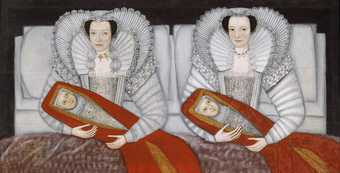
Unknown artist, Britain, The Cholmondeley Ladies c.1600–10. Tate.
1545–1640
19 rooms in Walk Through British Art
The grand portraits in this room tell stories of migration and power. They date from the last years of the reign of Henry VIII to the time of Charles I
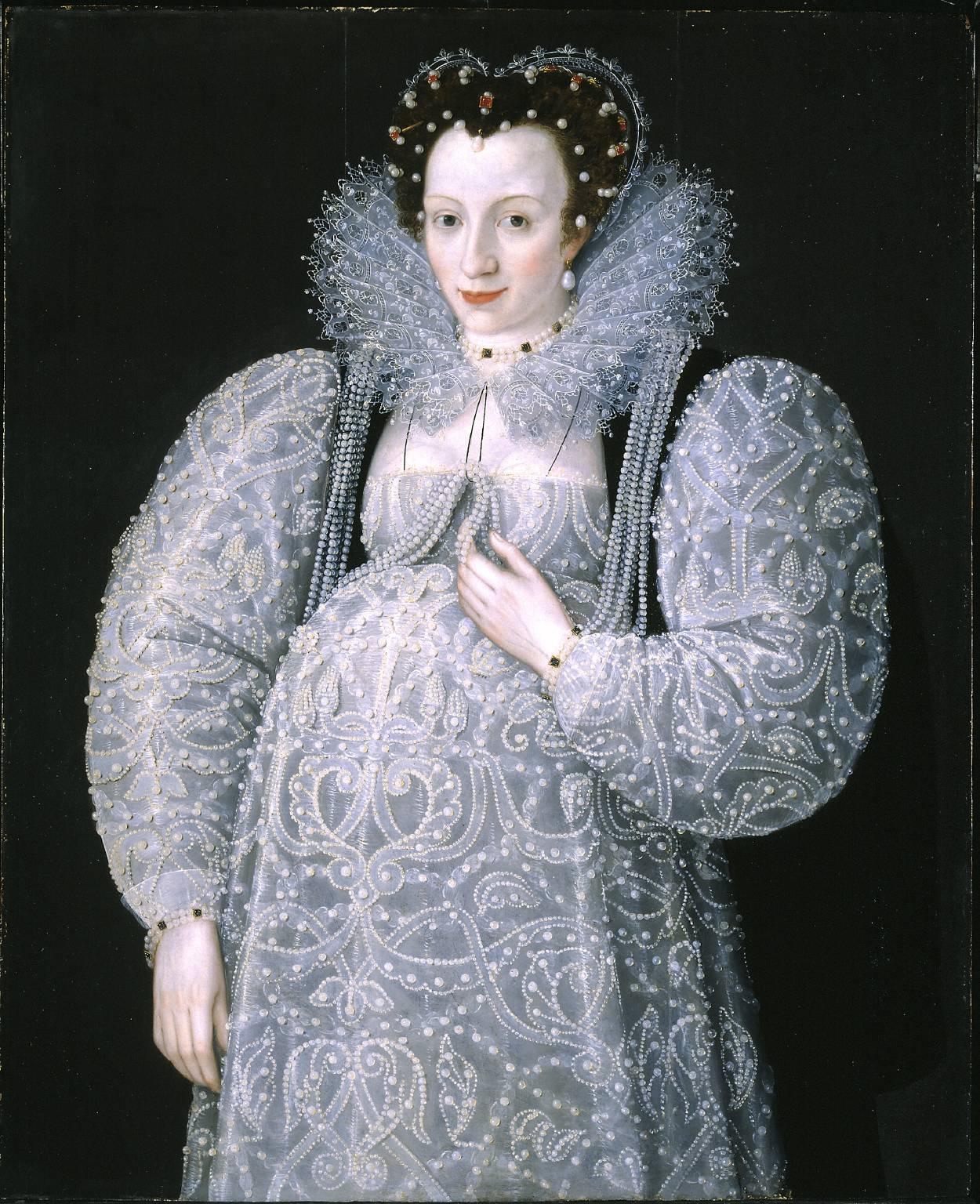
attributed to Marcus Gheeraerts II, Portrait of an Unknown Lady c.1595
The identity of this pregnant woman is not known, but her elaborate clothing suggests she was wealthy and upper class. The pearls on her outfit are symbols of ‘purity’. Huge importance was placed on monogamy for women in this period. This painting celebrates the sitter’s role in continuing her husband’s family line. She is smiling, which is unusual in portraits at this time. Gheerearts was a Flemish painter who worked at the court of Queen Elizabeth I.
Gallery label, August 2019
1/23
artworks in 1545–1640
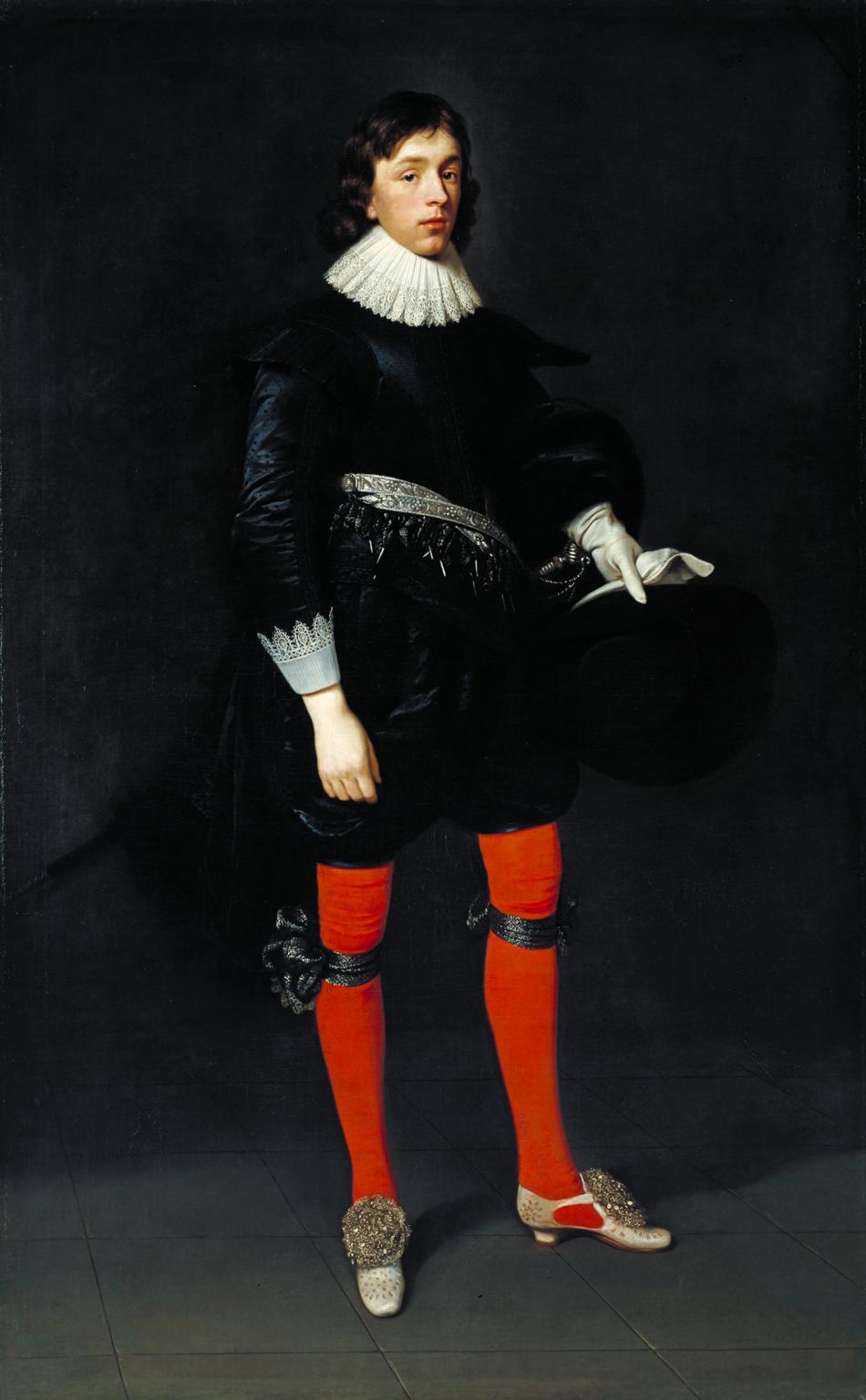
Daniel Mytens the Elder, Portrait of James Hamilton, Earl of Arran, Later 3rd Marquis and 1st Duke of Hamilton, Aged 17 1623
Mytens was born and trained in the Netherlands and from 1618 he worked in England. Compared with local artists, he offered a striking naturalism. Hamilton shared an interest in art-collecting with the future Charles I, whom Mytens painted in a similar pose. In 1623, the date of this picture, Hamilton had attended the Prince in Madrid during Charles’s unsuccessful attempt to marry a Spanish princess. There they saw portraits by the young Velasquez. Years later, during the Civil War, the royalist Hamilton was beheaded shortly after Charles himself.
Gallery label, February 2016
2/23
artworks in 1545–1640

Marcus Gheeraerts II, Portrait of Captain Thomas Lee 1594
Thomas was related to Sir Henry Lee, Elizabeth I's Champion and creator of imagery for her annual Accession Day celebrations. Henry may have helped devise the complex symbolism of this portrait. Thomas served in the English colonial forces in Ireland. His bare legs are a fantasy evocation both of the dress of an Irish soldier, and that of a Roman hero. Thomas was suspected of treachery to Elizabeth and visited London in 1594 partly to refute this. The Latin inscription in the tree refers to the Roman Mucius Scaevola, who stayed true to Rome even when among its enemies. Lee implies that he too is faithful.
Gallery label, May 2011
3/23
artworks in 1545–1640
Sorry, no image available
Unknown artist, Britain, formerly attributed to ?British School, ?16th Century, formerly attributed to Hans Holbein the Younger, Portrait of a Gentleman, probably of the West Family 1545–60
The identity of the sitter is uncertain, but is traditionally thought to be William West (born in 1519), later Baron De La Warr and nephew of the 9th Lord De La Warre, whom he tried to poison to gain the family estates. The ring he wears bears a heraldic motif associated with the West family. Analysis of the oak panel and the pigments used, along with the style of clothes and design of the sword hilt, dates the work to around 1550. The full-frontal pose shows the influence of the portrait of Henry VIII by Holbein, painted in the 1530s.
Gallery label, October 2013
4/23
artworks in 1545–1640
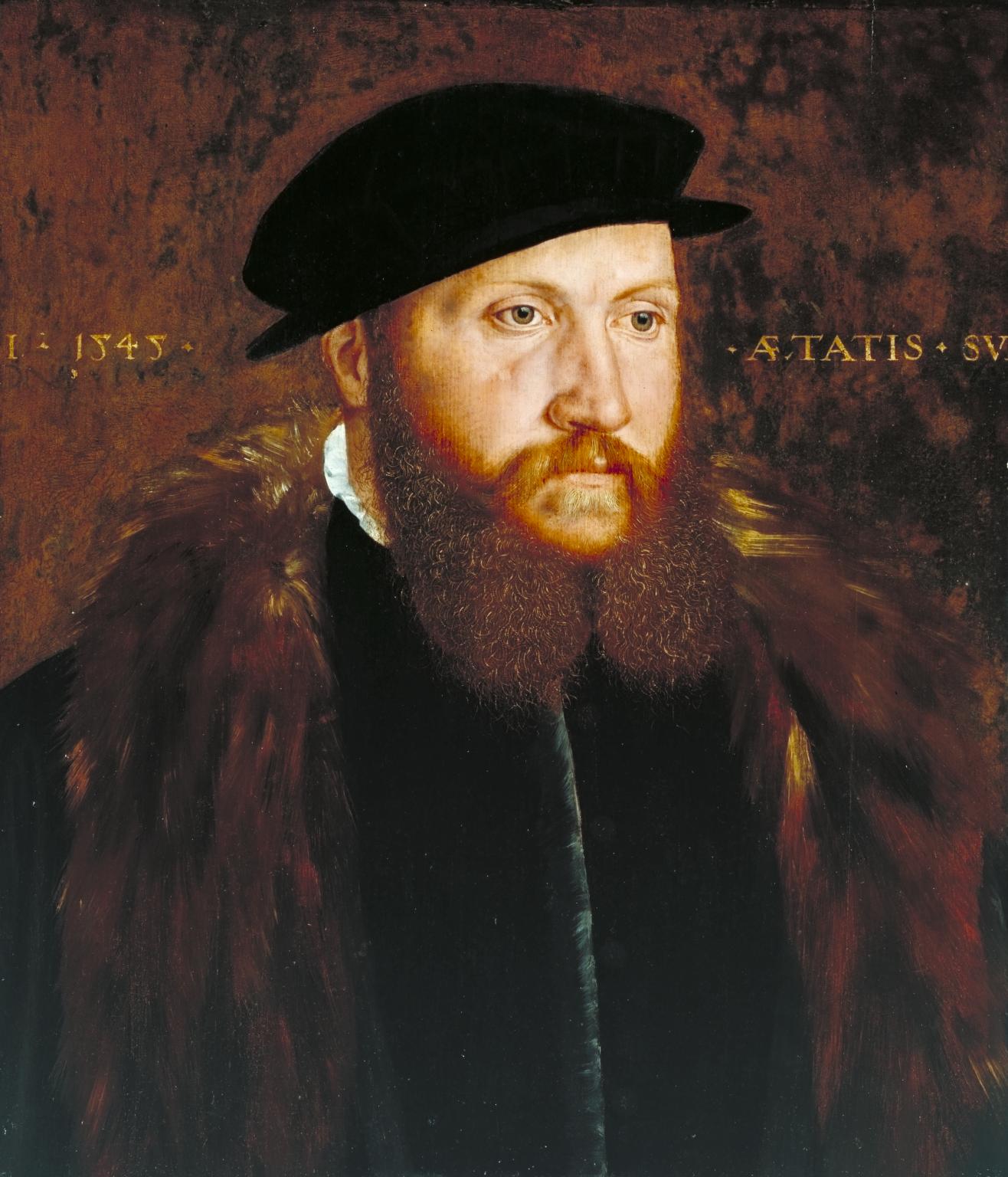
John Bettes, A Man in a Black Cap 1545
This is the earliest picture in the Tate collection. The artist’s name is inscribed on the back, and the inscriptions on the front indicate that the work was painted ‘in the year of our Lord 1545’, and that the sitter was aged 26. Bettes is first recorded carrying out decorative work for Henry VIII’s court in 1531–3, and he may have worked with Hans Holbein the Younger, the most famous Tudor painter. Originally this portrait was larger, and would have had a blue background similar to the colour often used by Holbein. Due to long exposure to light, the pigment (smalt) has changed to brown.
Gallery label, February 2016
5/23
artworks in 1545–1640
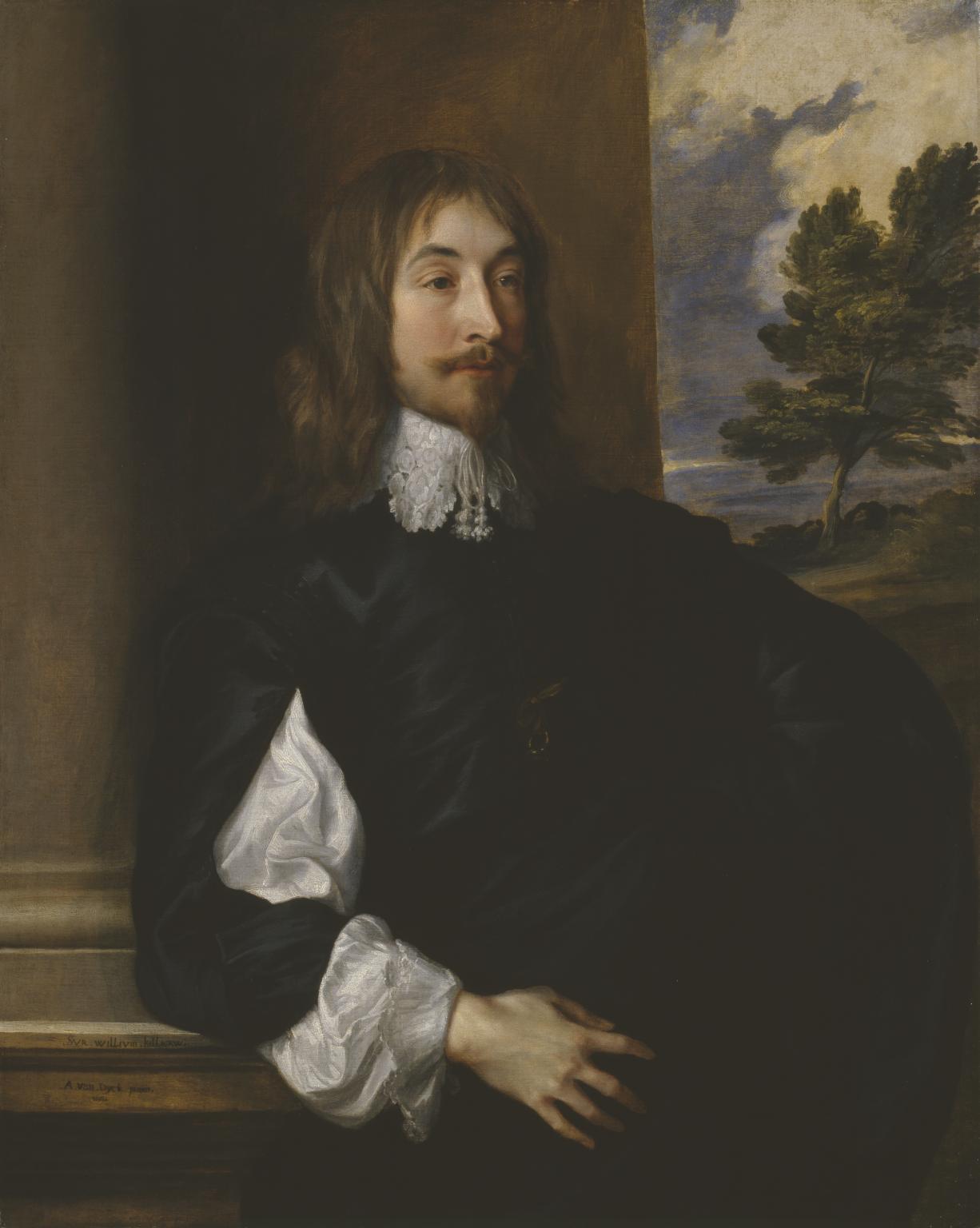
Sir Anthony Van Dyck, Portrait of Sir William Killigrew 1638
This portrait, and that of the sitter’s wife (displayed nearby) were designed as a pair. In both, the compositions and finely painted landscapes echo the work of the 16th-century Venetian painter Titian. Titian’s paintings were admired by the English king Charles I and his court, and greatly influenced van Dyck. Sir William was a courtier to Charles I and later a playwright. He is shown leaning meditatively against the base of a column. A ring, tied by a ribbon to his black satin jacket, may allude romantically to his wife, or denote mourning for a friend or relative.
Gallery label, February 2016
6/23
artworks in 1545–1640

George Gower, Lady Kytson 1573
Elizabeth Cornwallis (1546/7–1628) married Sir Thomas Kytson in 1560 (his portrait hangs nearby). As Roman Catholics under a Protestant ruler, Elizabeth I, the Kytsons were regularly fined. Indeed, Lady Kytson was briefly imprisoned for her faith. The couple were painted in London in 1573 by Gower, the foremost portraitist of the day. Subsequently, in 1584, Gower and the miniaturist Nicholas Hilliard tried to gain a monopoly to produce Elizabeth I’s portraits. As this painting demonstrates, Gower worked in the linear, shadowless style that the queen is known to have preferred.
Gallery label, February 2016
7/23
artworks in 1545–1640
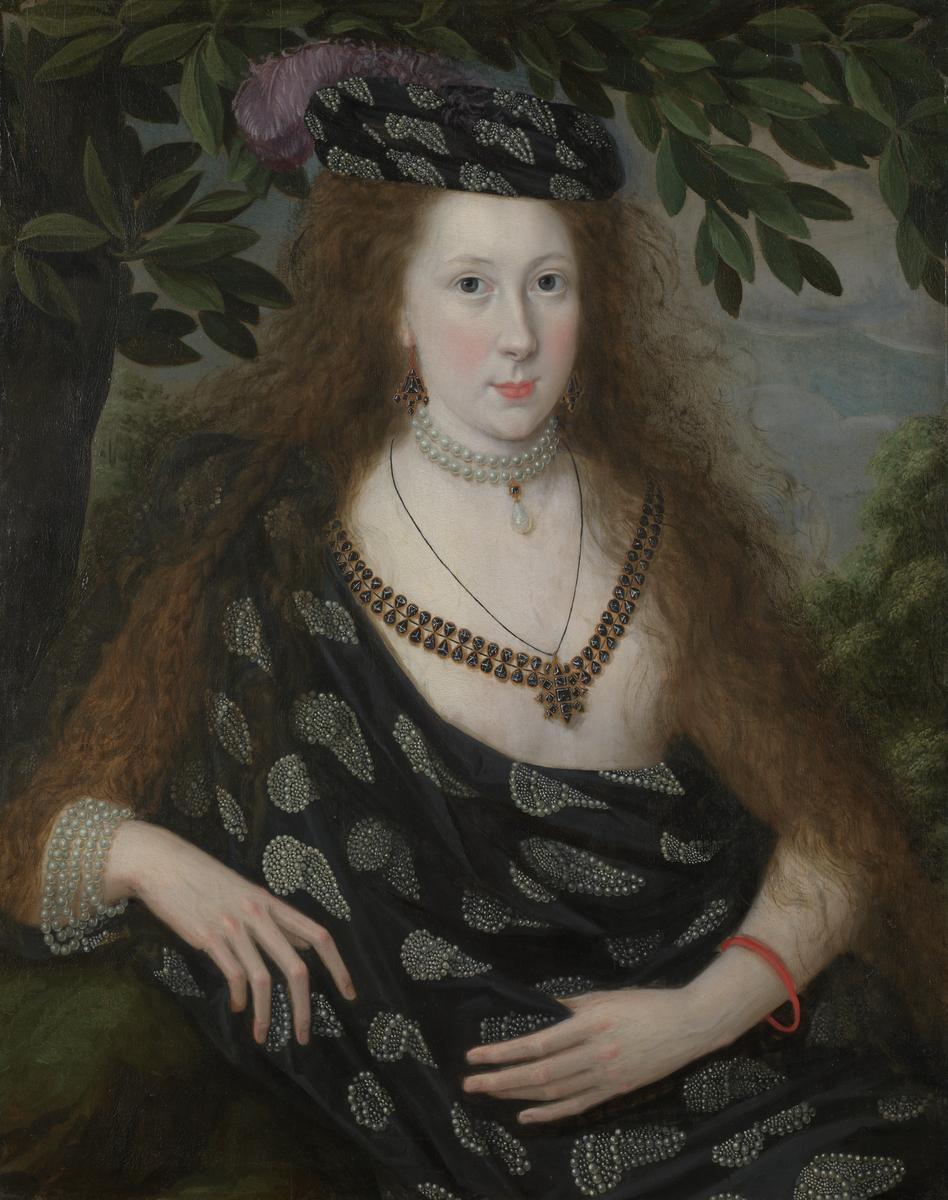
attributed to Robert Peake, Lady Elizabeth Pope c.1615
In 1615, Elizabeth Watson was married to Sir William Pope of Wroxton in Oxfordshire. She may be wearing a costume that relates to a masque – a court entertainment participated in by aristocrats. Her draped black cloak, or mantle, embroidered (like her hat) with pearls in a pattern of ostrich feathers, has classical precedents. So does her partly bared breast, a feature seen in surviving drawings of masque costumes by the court designer Inigo Jones (1573–1652). Like the miniaturist Nicholas Hilliard, Peake originally trained as a goldsmith. From 1607, Peake was joint court painter to James I.
Gallery label, May 2007
8/23
artworks in 1545–1640
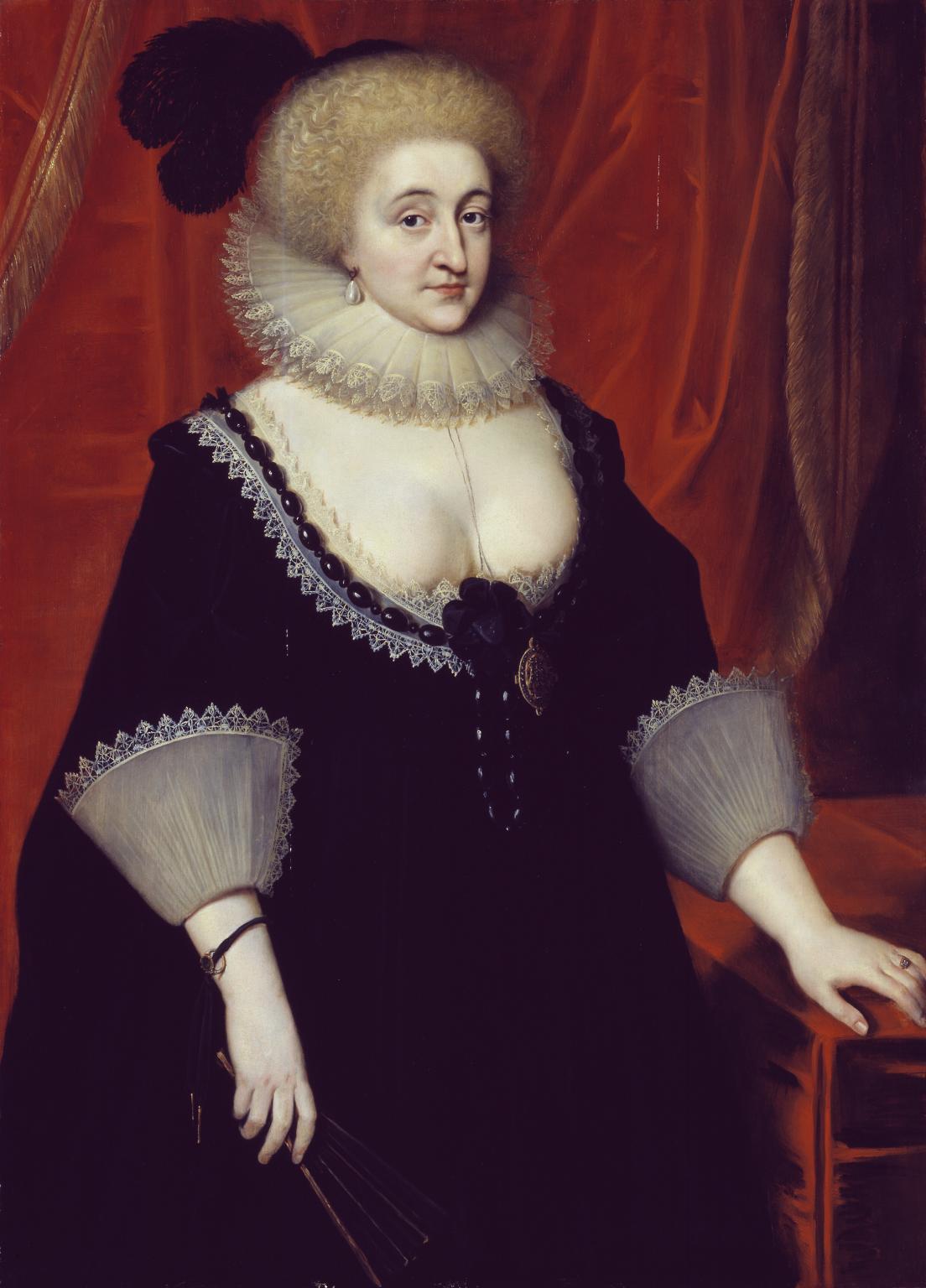
Paul Van Somer, Lady Elizabeth Grey, Countess of Kent c.1619
Van Somer came to Britain in 1616, and worked for Anne of Denmark, wife of the British king James I. This portrait may relate to her death early in 1619, for the sitter, who is dressed in black, had been a favoured attendant of Queen Anne. Under her heart, Lady Kent wears a jewel with the crowned monogram ‘AR’, standing for the Latin ‘Anna Regina’ (meaning ‘Anna the Queen’). It is probably a closed miniature-case, as a very similar example, given by the queen to another lady in waiting, is in the collection of the Fitzwilliam Museum, Cambridge.
Gallery label, February 2016
9/23
artworks in 1545–1640
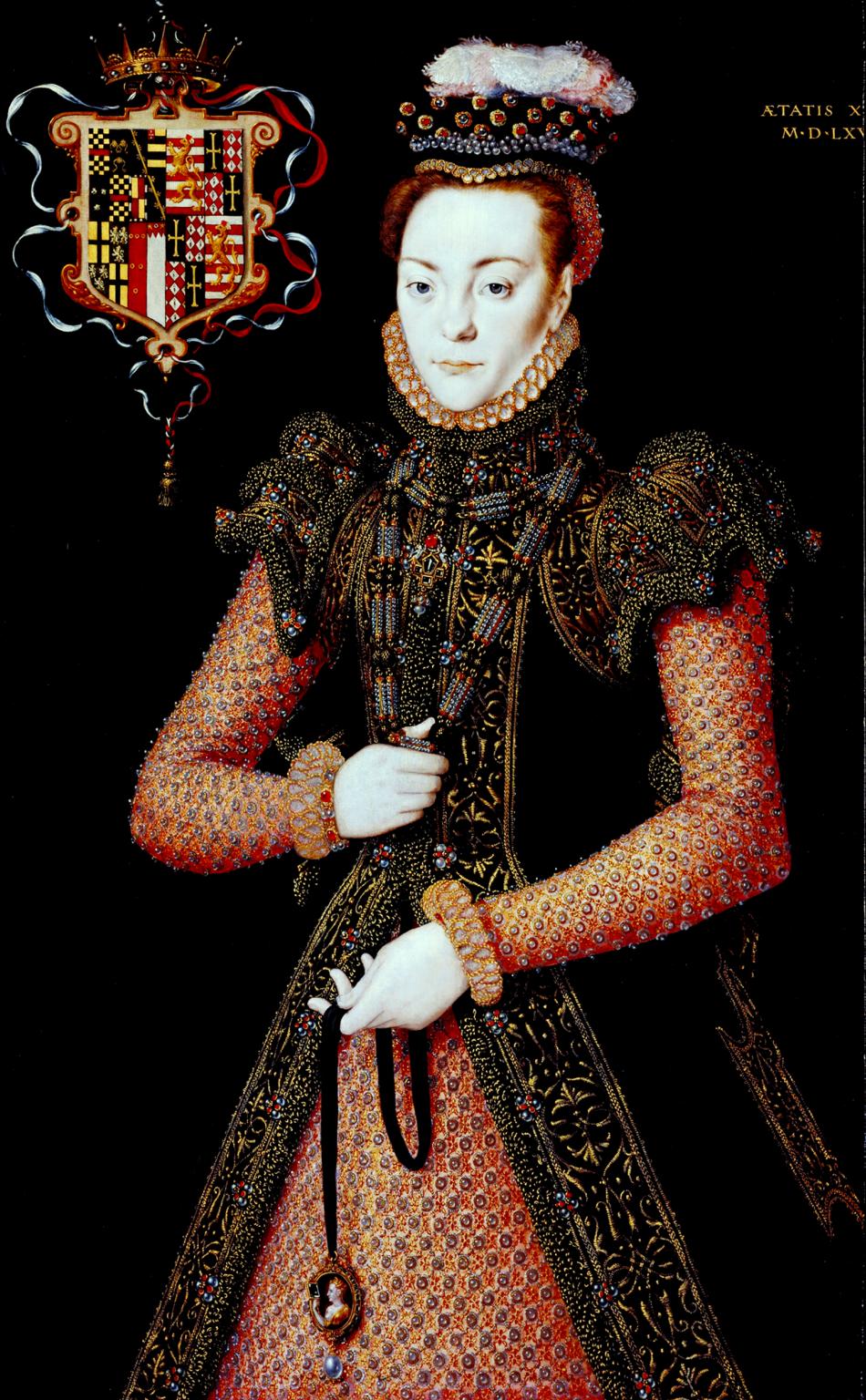
Hans Eworth, Portrait of an Unknown Lady c.1565–8
Her rich dress and jewels show that this woman was of high rank, although her identity is unclear. Her most notable piece of jewellery is the cameo suspended on a black ribbon. It shows the figure of Prudence, one of the cardinal virtues and considered then an especially appropriate quality in a woman. The remains of an inscription, upper right, date the picture to between 1565 and 1568. The large heraldic arms were added later; they belonged to Lady Eleanor Brandon, but she cannot be the woman depicted because she had died in 1547, around 20 years before this was painted.
Gallery label, February 2016
10/23
artworks in 1545–1640
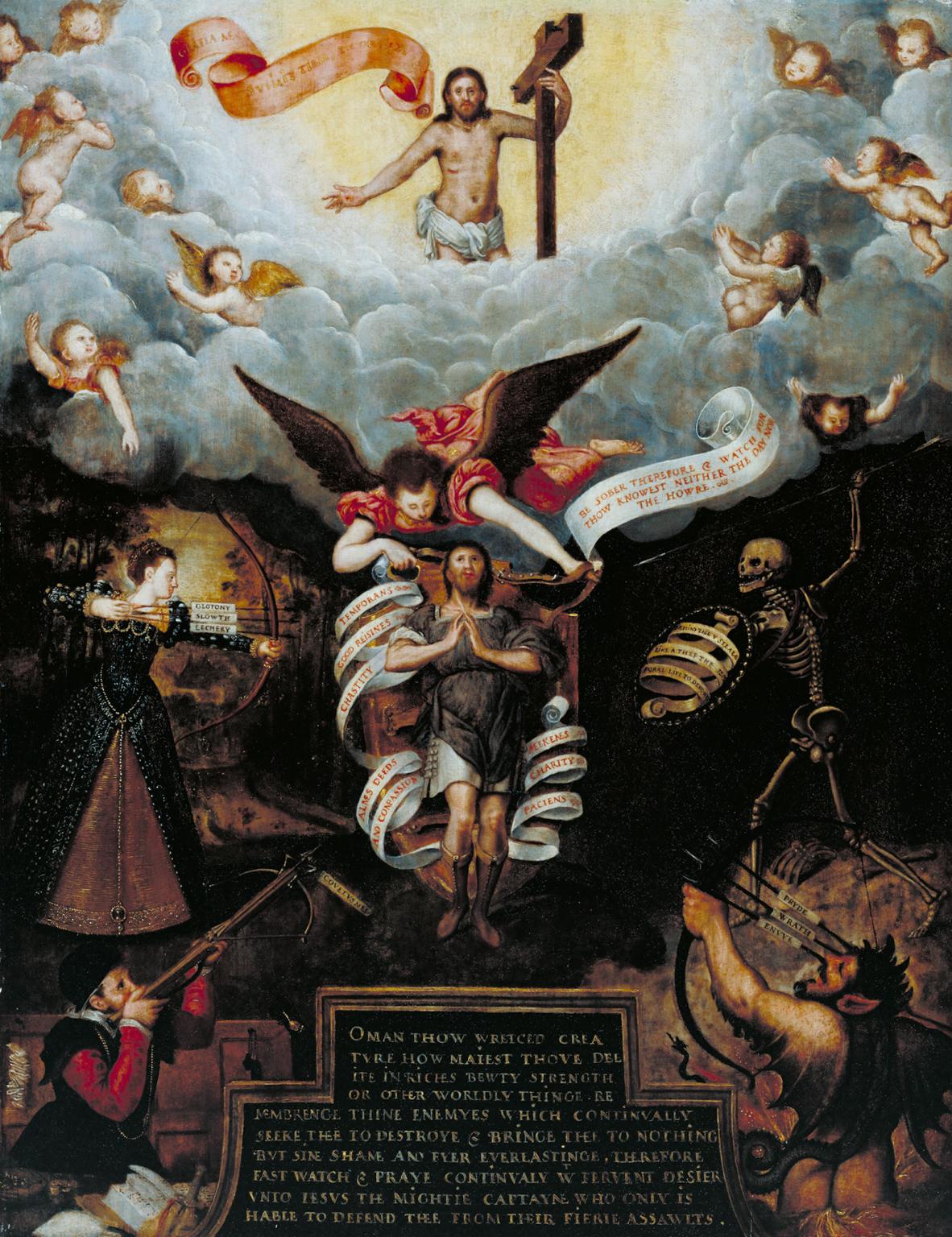
Unknown artist, Britain, An Allegory of Man 1596 or after
Extremely few British paintings of religious subjects have survived from the 16th century. After the Reformation, Protestant unease about images meant it would have been highly controversial to display either religious paintings or alabasters. The inscription at the bottom, in English, warns against the evil of worldly vanity. Instead it urges prayer to ensure the safe passage of the soul to heaven. The resurrected Christ appears at the top. Below him, at the centre, is Man, shielded by Christian and moral virtues against attacks from all sides by the Seven Deadly Sins.
Gallery label, February 2016
11/23
artworks in 1545–1640

David Des Granges, The Saltonstall Family c.1636–7
This great family piece is something of a puzzle. It apparently takes its inspiration from the elaborate dynastic tombs of the period, where the living and the dead are shown intermingled. Sir Richard Saltonstall draws back the red curtain round the bed that contains his deceased first wife, who gestures towards the couple’s two surviving children. He, meanwhile, gazes towards his second – living – wife, who sits holding her own Saltonstall baby. Des Granges, traditionally said to have produced this picture, mainly painted small-scale portrait miniatures.
Gallery label, May 2007
12/23
artworks in 1545–1640
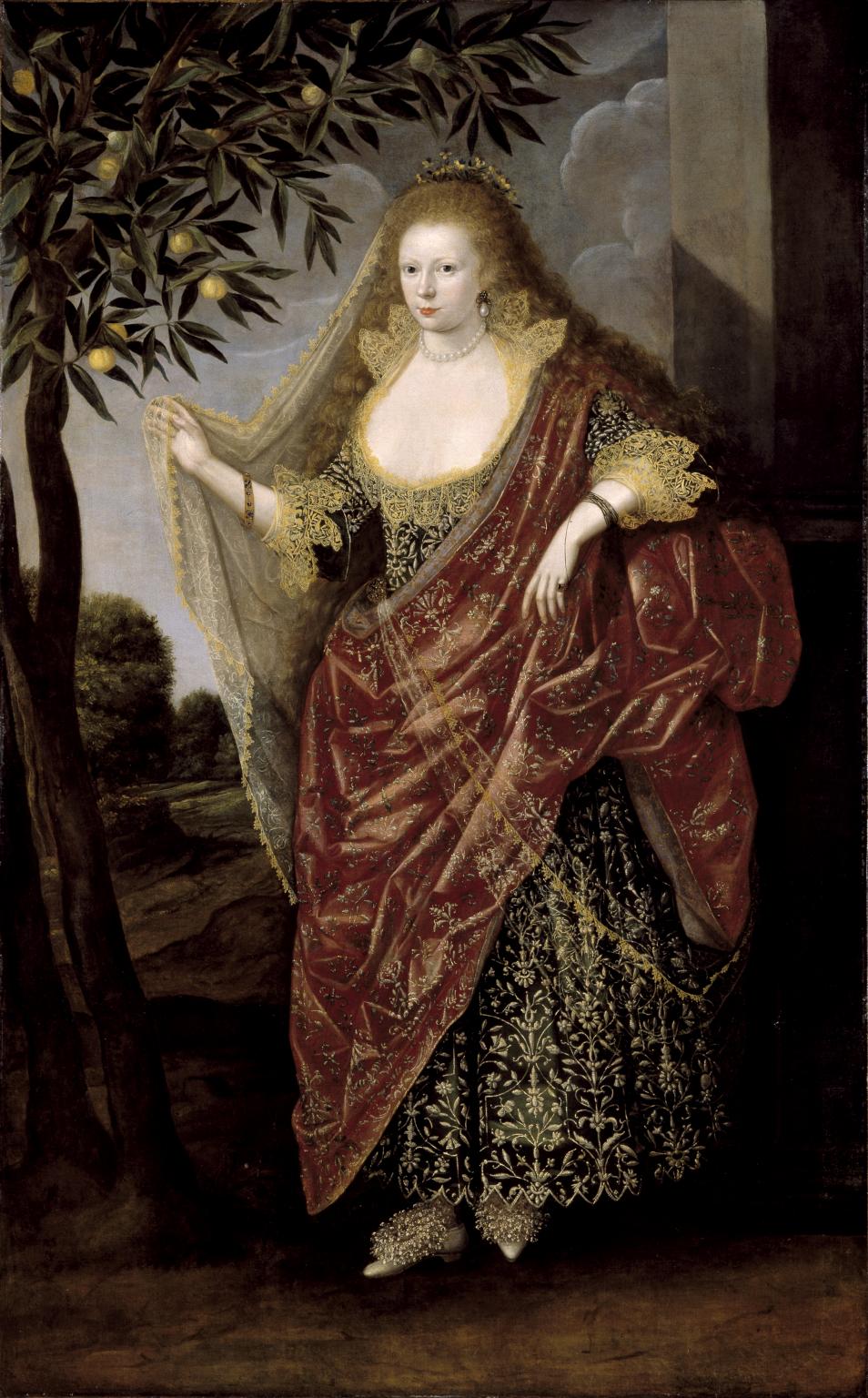
Unknown artist, Britain, Portrait of a Lady, Called Elizabeth, Lady Tanfield 1615
As with many portraits of the period, the identity of both sitter and artist is uncertain. The sitter is now thought to be Elizabeth Tanfield (1585/6–1639). Tanfield would have been about 30 years old when this was painted. She was an English poet, playwright, translator, and historian. Tanfield is the first woman known to have written and published a play in English. A number of unusual features of the painting, including the flowers in the woman’s hair, the peach tree, and the lifting of her shawl as if to shield the sun, all suggest that the portrait had a personal meaning that is now lost.
Gallery label, December 2019
13/23
artworks in 1545–1640
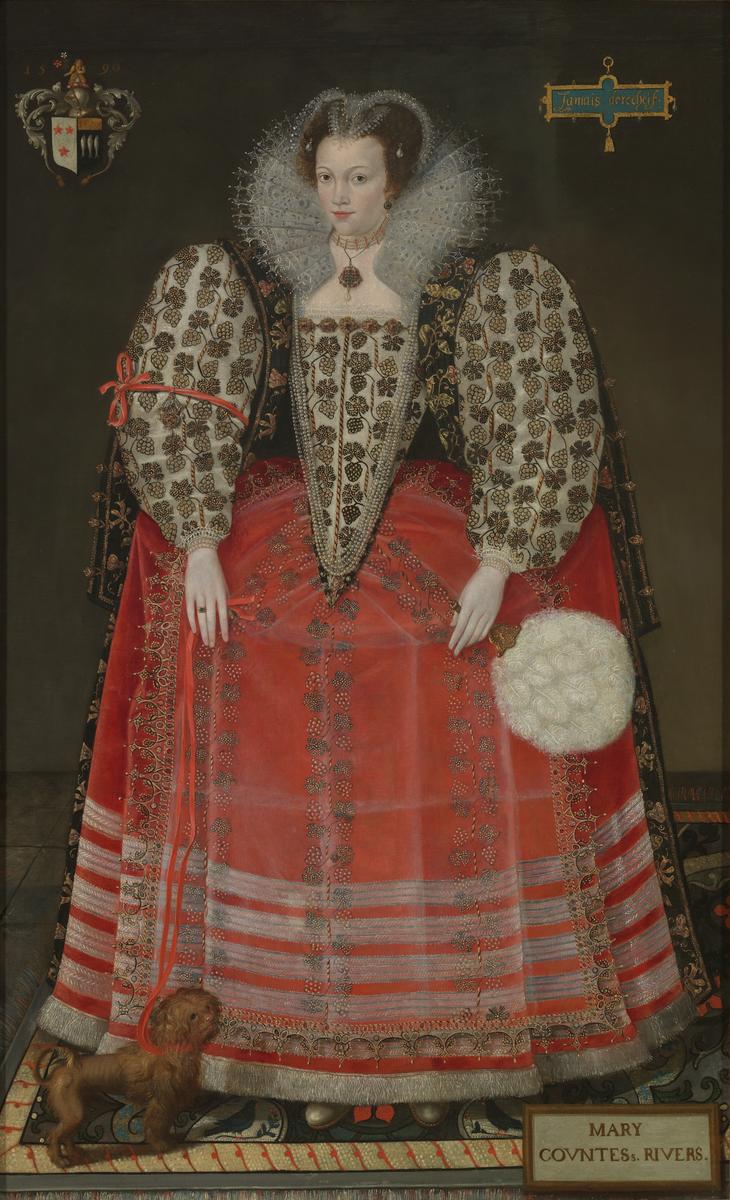
Unknown artist, Britain, Portrait of Mary Kytson, Lady Darcy of Chiche, later Lady Rivers c.1590
The inscription, bottom right, identifies this sumptuously dressed lady as Mary, the unhappy wife of Thomas, 3rd Baron Darcy of Chiche. The couple were to separate in 1594. Thirty-six years after this portrait was painted, Thomas became the Earl Rivers. Mary’s white sleeves and stomacher are embroidered with hops and carnations, and her black sleeveless gown with honeysuckle. An earlier portrait of Mary’s mother, Lady Kytson, also hangs on this wall, to the left. Both paintings once hung at the Kytsons’ Suffolk house, Hengrave Hall. The French inscription, top right, means roughly ‘never act in haste.’
Gallery label, May 2007
14/23
artworks in 1545–1640

Unknown artist, Britain, Portrait of a Lady, probably Mrs Clement Edmondes c.1605–10
The inscription on the book refers to the translation of Caesar’s Commentaries made by Clement Edmondes (?1564–1622) Remembrancer of the City of London. He may have owed his advancement to the court connections of his wife, Mary Clerke, attendant on Elizabeth I’s Gentlewoman of the Privy Chamber, Lady Stafford. Queen Elizabeth often gave away pieces of her clothing and it is thought that the richly embroidered petticoat here worn by Mary Edmondes may be one such item.
Gallery label, May 2007
15/23
artworks in 1545–1640
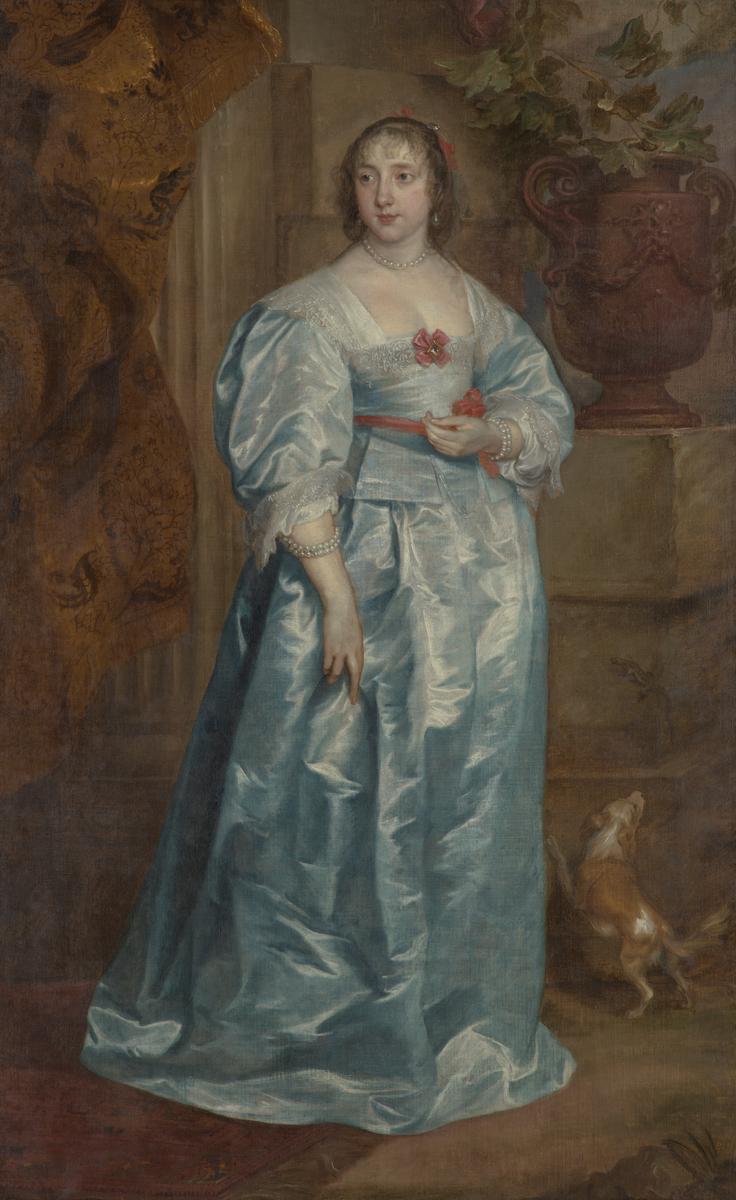
Sir Anthony Van Dyck, A Lady of the Spencer Family c.1633–8
We don’t know exactly who this woman was. The dog and the lizard it is chasing are symbols of fidelity, which suggest she may have been engaged or newly married. Van Dyck was born and trained in Antwerp. He worked in Rubens’s studio and travelled in Italy, studying the work of Titian, before moving to London in 1632. In the same year he was knighted and appointed Charles I’s Principal Painter. His portraits gave his royal and aristocratic sitters an unprecedented glamour and elegance and had a profound influence on the course of British portraiture.
Gallery label, February 2010
16/23
artworks in 1545–1640
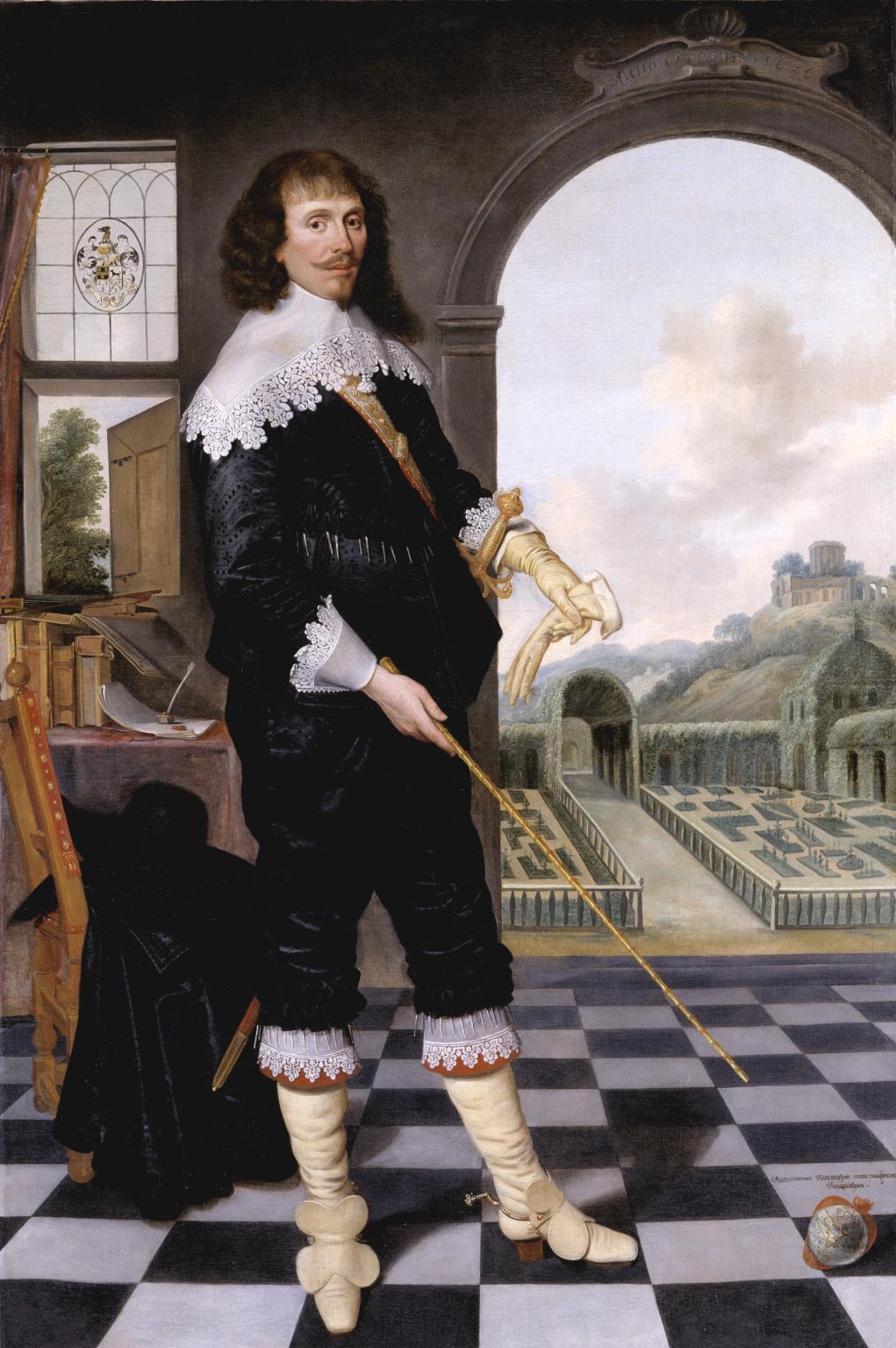
Unknown artist, Britain, Portrait of William Style of Langley 1636
Style was a lawyer involved in the Counter-Reformation religious movement and his portrait is full of symbolic elements. The emblem on the floor and its motto proclaim that the human heart cannot be satisfied by worldly matters, but burns for the spiritual life. Style therefore turns his back on the trappings of his earthly life, represented by his family arms set in the window, by his books and writings and by the small violin. Instead, he moves towards the Church, symbolised by a closed garden, beyond which lies a pagan wilderness, including a classical ruin.
Gallery label, February 2016
17/23
artworks in 1545–1640
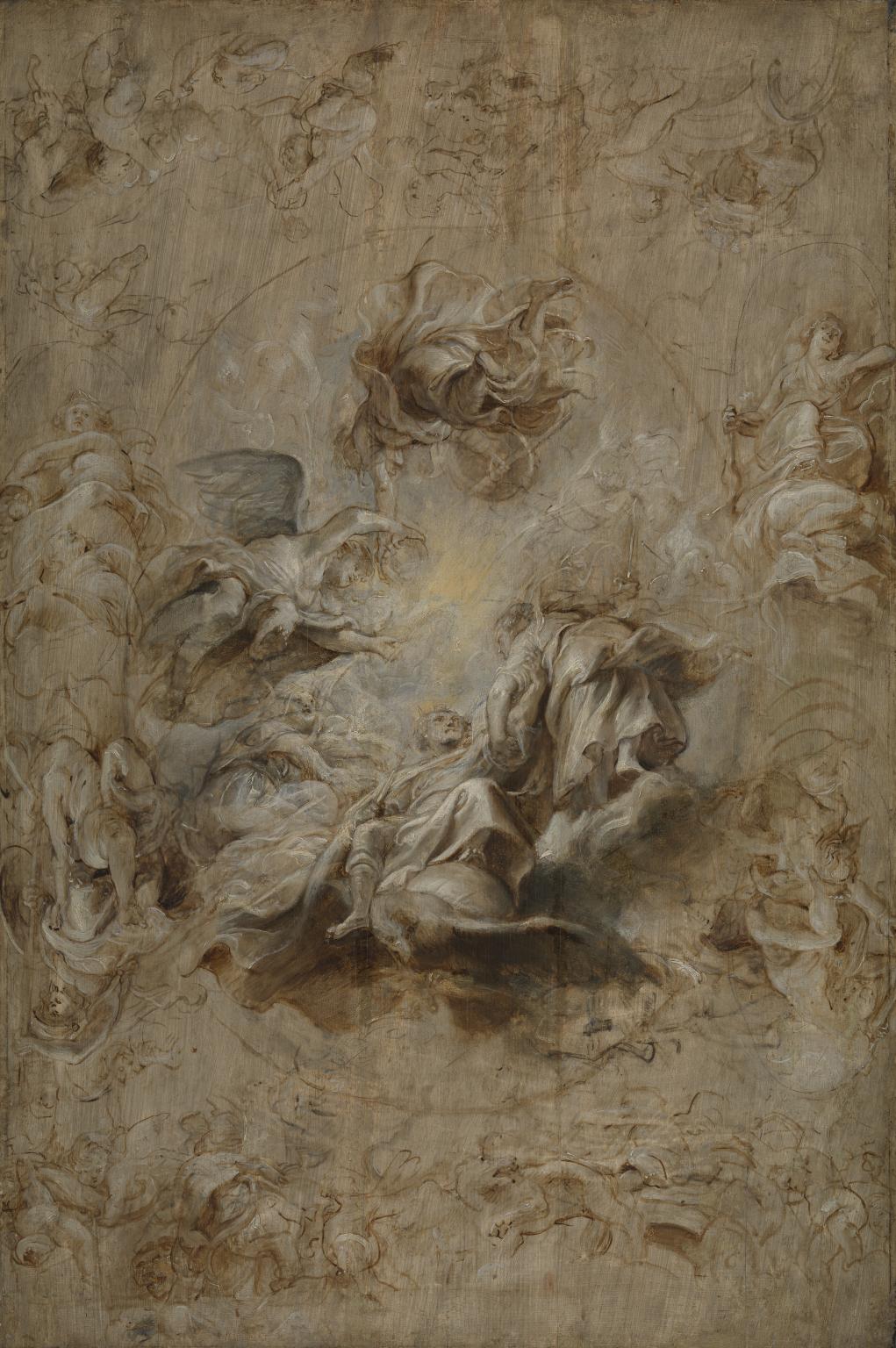
Sir Peter Paul Rubens, The Apotheosis of James I and Other Studies: Multiple Sketch for the Banqueting House Ceiling, Whitehall c.1628–30
This is a sketch for the ceiling of the Banqueting House at Whitehall Palace. King Charles I wanted it to celebrate his father James I’s reign. He commissioned Rubens, who was visiting London to negotiate a peace treaty with Spain. In the centre James is seated on a globe being lifted up to heaven by Jupiter’s eagle. He is guided by the figure of Justice, to be crowned by Minerva (goddess of Wisdom) and Victory. ‘Apotheosis’ is the transformation from human to divine.
Gallery label, August 2019
18/23
artworks in 1545–1640
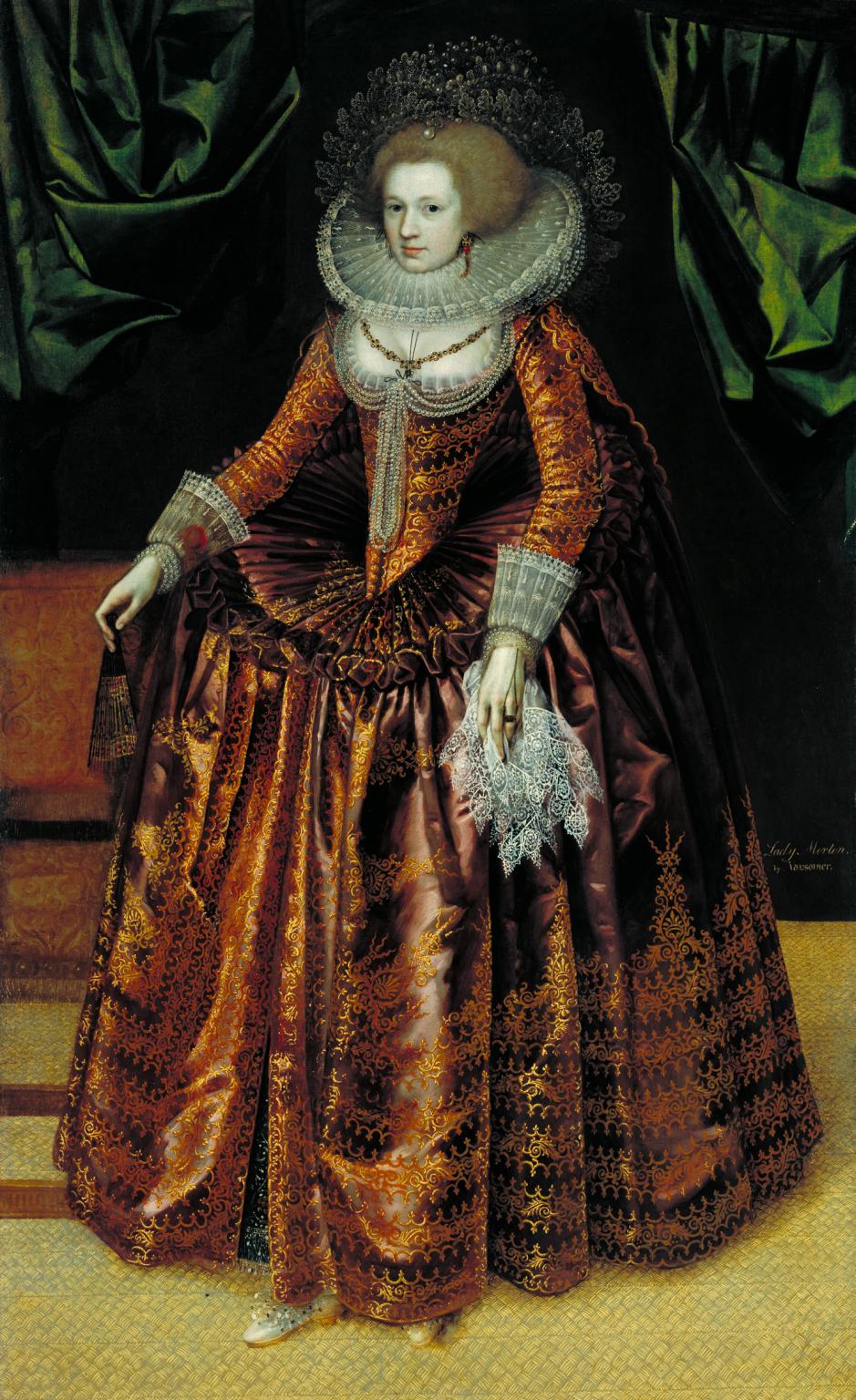
Unknown artist, Britain, Portrait of Anne Wortley, Later Lady Morton c.1620
This typifies the British Jacobean portrait formula. The subject appears full length and almost facing the viewer, standing on a rich carpet or, as here, on rush matting, flanked by lustrously painted curtains. There may be an accompanying chair or table, but the artist shows no interest in conveying its spatial relationship to the figure. The costume is meticulously depicted, with an almost hallucinatory clarity.
Anne Wortley's face and hands are painted in a more shadowed manner, associated with Netherlandish-trained artists. The portrait may have been produced by painters collaborating in a workshop, rather than by a single artist
Gallery label, August 2004
19/23
artworks in 1545–1640
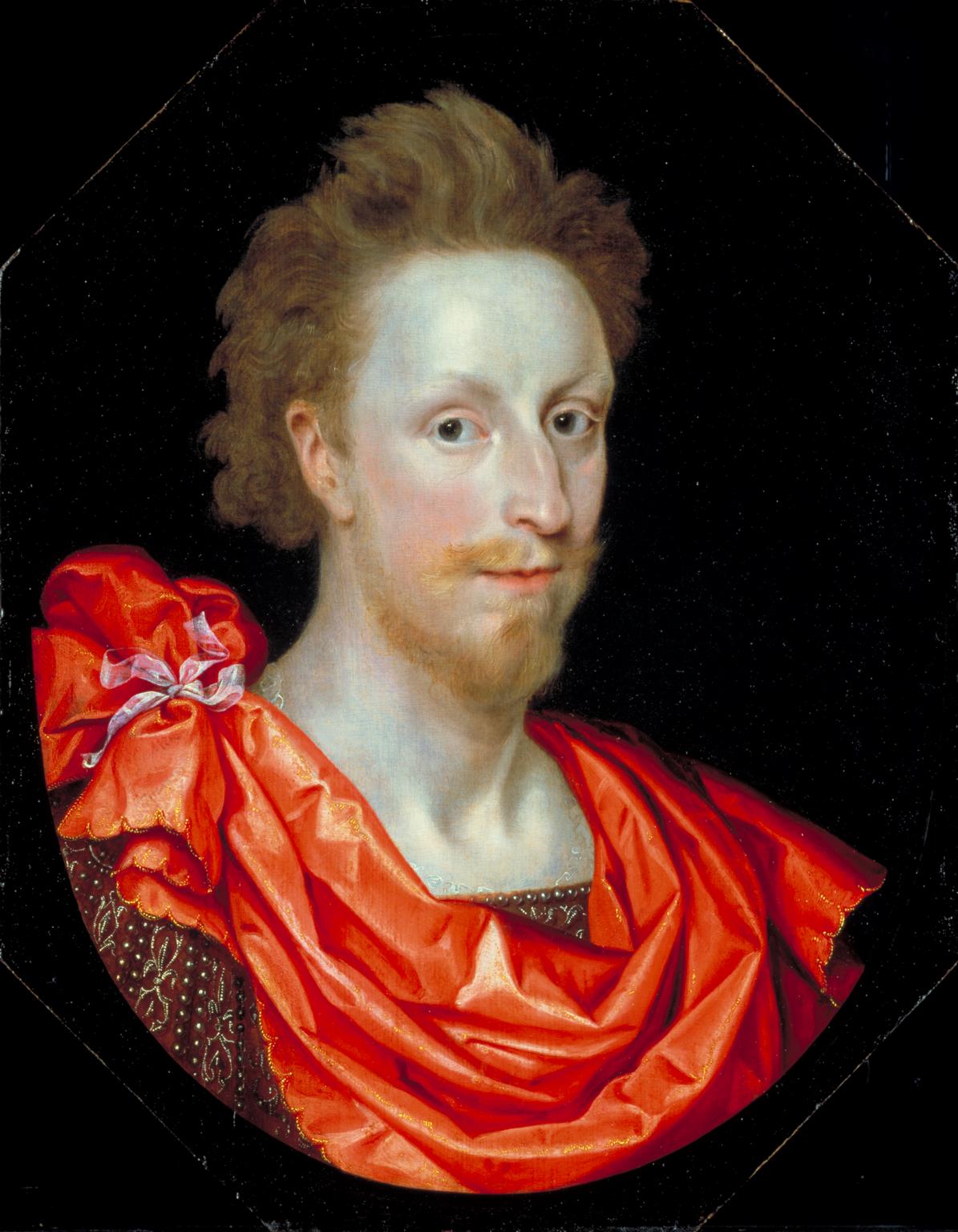
Marcus Gheeraerts II, Portrait of a Man in Classical Dress, possibly Philip Herbert, 4th Earl of Pembroke c.1610
This octagonal painting is one of a pair of portraits (the companion portrait is now at Stanford University, California). It may show the aristocrat Philip Herbert. . The First Folio of Shakespeare's plays, published after his death, was dedicated to Philip and his brother William, 3rd and 4th earls of Pembroke.The head is set within a painted oval similar to contemporary oval portrait miniatures by Isaac Oliver, which show elite court figures in versions of classical dress. The sitter's clothes echoe surviving costume designs by Inigo Jones for the extravagant court entertainments called 'masques'.
Gallery label, May 2007
20/23
artworks in 1545–1640
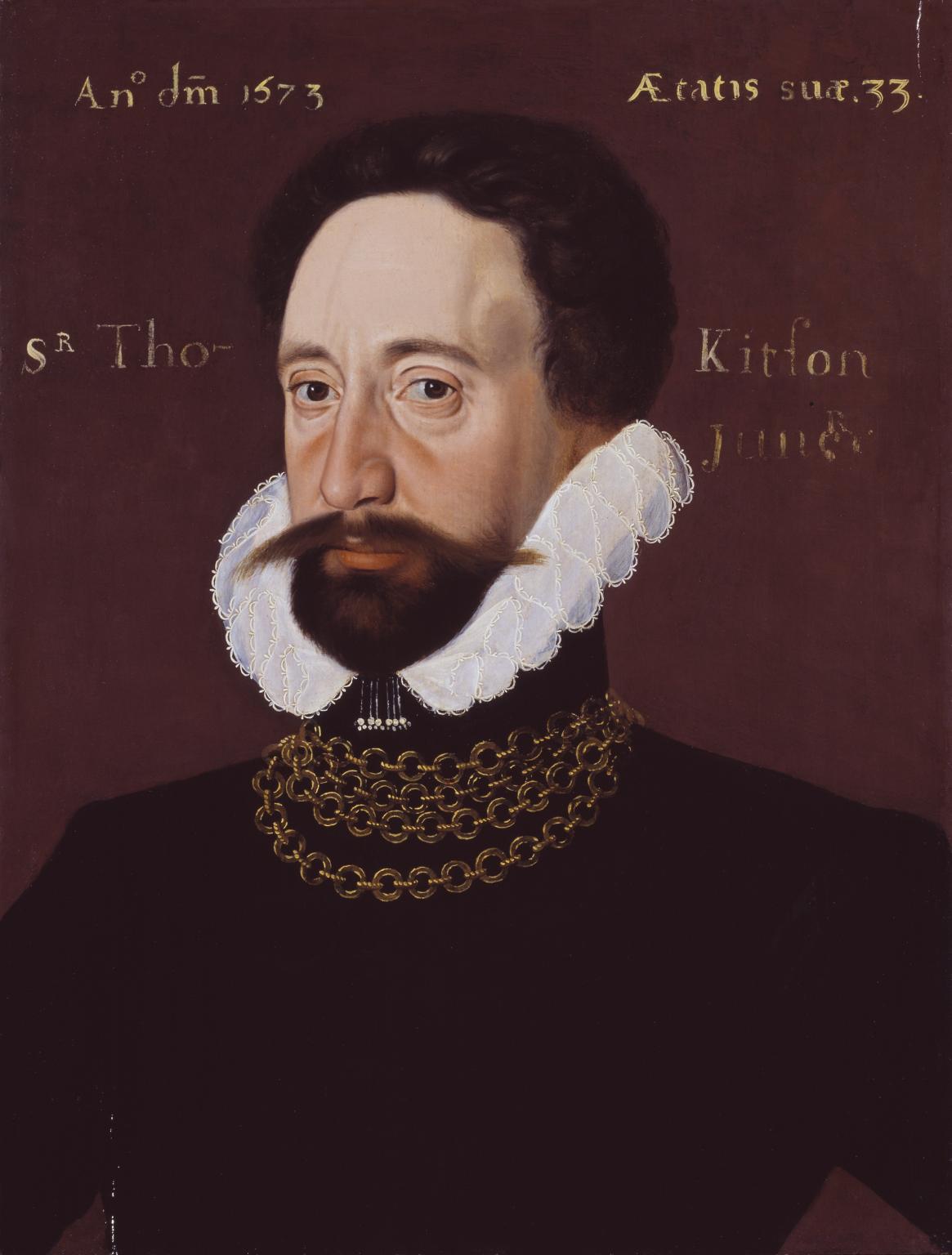
George Gower, Sir Thomas Kytson 1573
Gower, who was from a family of Yorkshire gentry, was an important portrait-painter in the 1570s and 1580s. In 1581 he became Serjeant-Painter to Elizabeth I, and supervised decorative painting in the royal palaces. Sir Thomas Kytson (1540–1603) of Hengrave, Suffolk, visited London with his second wife Elizabeth between March and June 1573. The family papers record a payment ‘to Gower of London, painter’ for pictures. Sir Thomas’s portrait, and that of his wife which hangs nearby, remained at Hengrave Hall until 1952. They were presumably originally the same size, but his picture was trimmed at a later date.
Gallery label, February 2016
21/23
artworks in 1545–1640
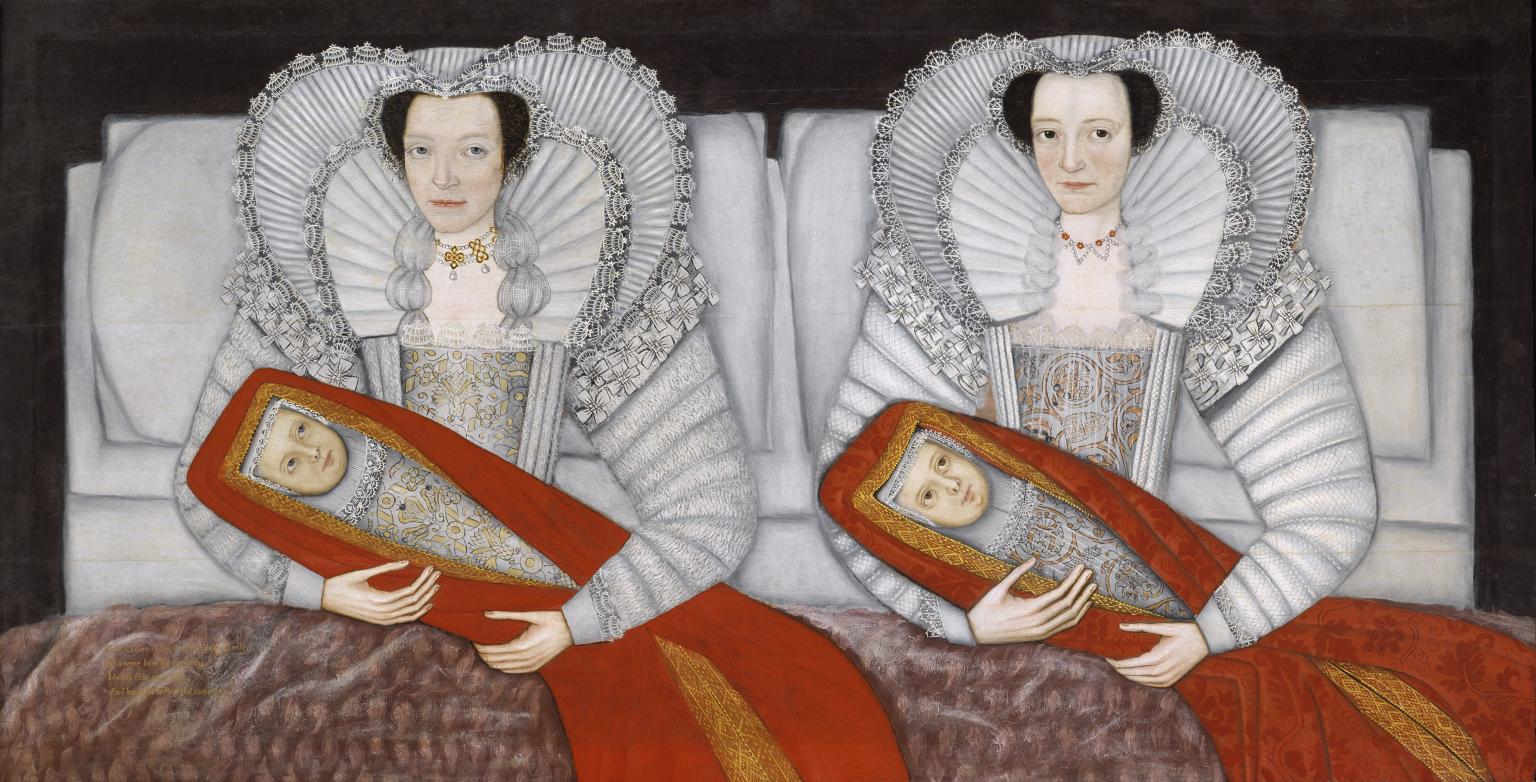
Unknown artist, Britain, The Cholmondeley Ladies c.1600–10
According to the inscription (bottom left), this painting shows ‘Two Ladies of the Cholmondeley Family, Who were born the same day, Married the same day, And brought to Bed [gave birth] the same day’. To mark this dynastic event, they are formally presented in bed, their babies wrapped in scarlet fabric. Identical at a superficial glance, the lace, jewellery and eye colours of the ladies and infants are in fact carefully differentiated. The format echoes tomb sculpture of the period. The women, whose precise identities are unclear, were probably painted by an artist based in Chester, near the Cholmondeley estates.
Gallery label, February 2016
22/23
artworks in 1545–1640
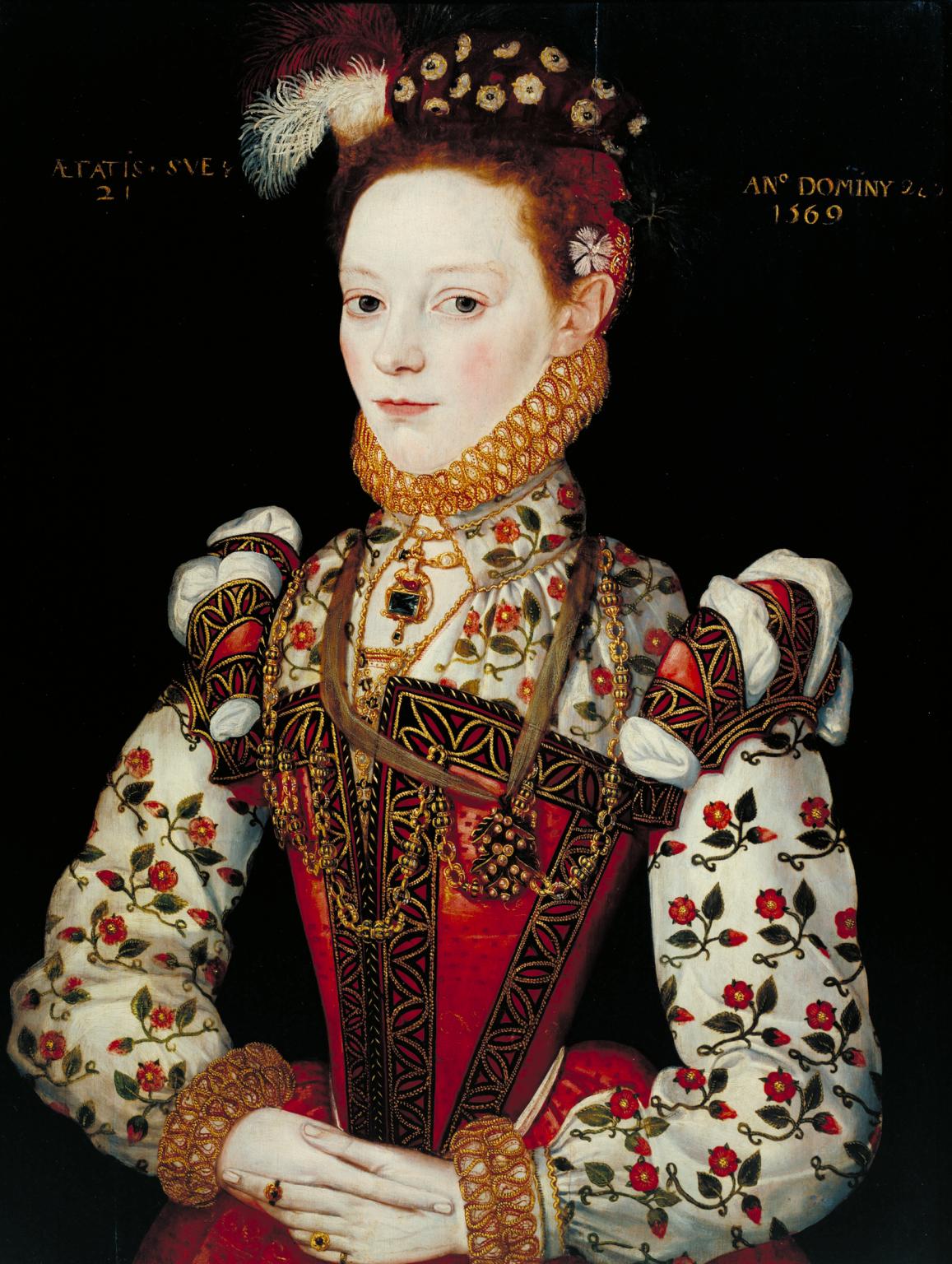
Unknown artist, Britain, A Young Lady Aged 21, Possibly Helena Snakenborg, Later Marchioness of Northampton 1569
A number of portraits from the 1560s seem to be by the painter of this work, whose identity is unknown. Characteristic features include the angle at which the face is presented and the soft treatment of the hair. The sitter may be Elizabeth I’s maid of honour, Helena Snakenborg, who became a powerful figure at court. In 1565 she had visited England with the Swedish princess Cecilia, remaining there as the fiancée of the elderly Marquis of Northampton, whom she was to marry in 1571. The carnation behind her ear may be a symbol of her betrothal.
Gallery label, February 2016
23/23
artworks in 1545–1640
Art in this room



Sorry, no image available



















You've viewed 6/23 artworks
You've viewed 23/23 artworks
